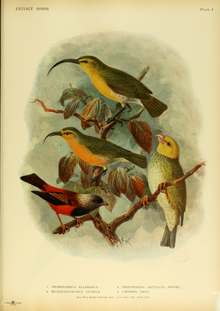- ʻUla-ʻai-Hawane
-
ʻUla-ʻai-hawane 
Conservation status Scientific classification Kingdom: Animalia Phylum: Chordata Class: Aves Order: Passeriformes Family: Drepanididae Genus: Ciridops Species: C. anna Binomial name Ciridops anna
(Dole, 1879)The ʻUla-ʻai-Hawane (Ciridops anna) was a small Hawaiian honeycreeper, now extinct. The term ʻUla-ʻai-Hawane is a Hawaiʻian phrase translating to "red [bird] that eats hawane". It was only ever reported from the forested mountains of the Kohala, Hilo and Kona districts on the island of Hawaiʻi. Fossil remains reveal that it (and at least one closely related species, Ciridops tenax) also existed at one time on other Hawaiʻian islands.
Contents
Description
The average length of the bird was around 11 centimetres (4.3 in). With respect to coloring, the adult was patterned red overall, while the head, throat, and upper back were silvery gray. The crown, wings, breast, shoulder, and tail were black, and the tertials a white color. The legs and bill were yellowish. Immature birds were brownish overall with a bluish-gray breast, black wings and tail, and a greenish-brown back.
Extinction
ʻUla-ʻai-Hawane are thought to have fed on the seeds and flowers of the loʻulu palms Pritchardia affinis, P. beccariana, P. lanigera and P. schattaueri.[citation needed] The bird's name suggests it liked the unripe fruits (hawane) particularly well. The decline of these palms may have sealed the fate of the bird. As the ʻUla-ʻai-Hawane was only ever seen near loʻulu palms, it is assumed that they were fully dependent on them for survival. The last confirmed sighting of the bird was in the Kohala Mountains in 1892; a bird apparently sporting the rather distinctive coloration of this species was also seen in 1937, but too briefly to be unequivocally identified.
References
- ^ BirdLife International (2008). Ciridops anna. In: IUCN 2008. IUCN Red List of Threatened Species. Downloaded on 23 April 2009.
External links

This Fringillidae-related article is a stub. You can help Wikipedia by expanding it.


